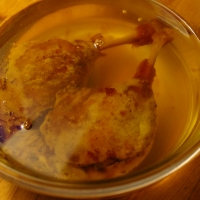Duck Confit - Confit De Canard ( Thomas Keller )
From PongoUSA 13 years agoIngredients
GREEN salt (MAKES ABOUT 1/2 CUP)
- 1/2 cup kosher salt shopping list
- 2 bay leaves, broken into pieces shopping list
- 2 tablesp. Chopped thyme shopping list
- 1/4 cup Packed Italian parsley leaves shopping list
- 1 teasp. black peppercorns shopping list
- [section]Duck[/section} shopping list
- 6 8-ounce whole Pekin (Long Island) duck legs shopping list
- 5-6 cups Rendered duck fat, melted shopping list
How to make it
- There are countless ways to flavor duck confit, but to my taste, the simpler the better - some salt, pepper, fresh herbs.
- FOR THE GREEN SALT: Place the salt in a coffee or spice mill or small food processor. Add the bay leaves, thyme, parsley, and peppercorns. (If all the herbs do not fit, start grinding the mixture using only part of the parsley, then add more as the leaves break down.) Process until well combined and a vivid green. Set aside.
- FOR THE DUCK: Rinse the duck legs under cold running water and pat dry with paper towels. Pull away and discard any excess fat. With scissors, trim excess skin near the bottom of the legs and around the edges, leaving 1/4 inch overhang of skin. The skin and fat can be discarded or rendered. To render the fat, place the trimmed fat and skin in a small saucepan with a tablespoon of water. Heat on a heat diffuser over low heat for several hours, allowing the fat to melt and render, then strain the fat. Use in the confit or save for other uses. Cover and refrigerate.
- Once the legs are trimmed, weigh them so you won't oversalt them. The correct proportion is 2 tablespoons of green salt to 1 pound duck legs, or about 1 tablespoon per leg. Rub the salt over the legs, rubbing a little extra on the thicker parts and around the joint. Place the legs flesh side up in a single layer in a baking dish that holds them comfortably (use two if necessary). Cover with plastic wrap and refrigerate for 24 hours.
- FOR THE CONFIT:
- I just put them in the slow cooker, low setting, pour the warmed duck fat over them and cook for 8 hours. Here is Kellers way : Place an oven thermometer in the center of the oven and preheat the oven to 190°F. It is important to check the heat from time to time while the legs cook to be certain that the oven maintains the proper temperature. Rinse the legs well under cold water and dry thoroughly with paper towels. Layer the duck legs (no more than 2 deep) in a 9- to 10 inchwide heavy ovenproof pot with a lid. Pour enough melted duck fat to cover the legs. Place over medium heat just until the fat is warm. Cover, place in the oven, and cook for 10 hours.
- Check a duck leg by carefully lifting it from the fat and piercing it with a paring knife. The meat should he meltingly tender; if necessary, return the duck to the oven for up to 2 hours longer, checking the legs frequently, but keep in mind that if they are cooked for too long, later they may fall apart as they are sauteed. Remove the legs from the oven and cool them in the fat. Once they have cooled enough to handle, gently lift the legs from the fat and place in a container. Strain the fat over the legs, submerging them in fat; transfer them to a smaller container if not completely covered with the fat. Cover and refrigerate for up to 2 weeks.
- TO USE: When you are ready to use the duck legs, remove the
- container from the refrigerator and allow it to sit at room temperature for a few hours in order to soften the fat enough to remove the desired quantity of legs without breaking them.
- NOTE: You can keep confit for months rather than weeks if you remove
- all meat juices from the fat. To do this, separate the confited duck or rabbit from the fat and refrigerate the fat. As the fat solidifies, the meat juices will settle to the bottom of the container, where they'll gel. When the fat is sufficiently firm, carefully spoon it off the top, without disturbing the gel. Discard the gel, melt the fat, and pour it over the duck or rabbit.
People Who Like This Dish 1
- clbacon Birmingham, AL
- PongoUSA San Francisco Peninsula, CA
- Show up here?Review or Bookmark it! ✔
The Groups
- Not added to any groups yet!


Reviews & Comments 1
-
All Comments
-
Your Comments